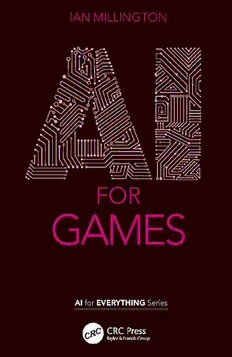Table Of ContentAI FOR GAMES
AI FOR EVERYTHING
Artificial intelligence (AI) is all around us. From driverless cars to
game-winning computers to fraud protection, AI is already involved
in many aspects of life, and its impact will only continue to grow
in the future. Many of the world’s most valuable companies are
investing heavily in AI research and development, and not a day goes
by without news of cutting-edge breakthroughs in AI and robotics.
The AI for Everything series will explore the role of AI in contemporary
life, from cars and aircraft to medicine, education, fashion, and
beyond. Concise and accessible, each book is written by an expert
in the field and will bring the study and reality of AI to a broad
readership including interested professionals, students, researchers,
and lay readers.
AI for Immunology AI for Radiology
Louis J. Catania Oge Marques
AI for Cars AI for Games
Hanky Sjafrie & Josep Aulinas Ian Millington
AI for Digital Warfare AI for School Teachers
Niklas Hageback & Daniel Hedblom Rose Luckin & Karine George
AI for Art AI for Learners
Niklas Hageback & Daniel Hedblom Carmel Kent, Benedict du Boulay & Rose
Luckin
AI for Creativity
Niklas Hageback AI for Social Justice
Alan Dix and Clara Crivellaro
AI for Death and Dying
Maggi Savin-Baden
For more information about this series please visit:
https://www.routledge.com/AI-for-Everything/book-series/AIFE
A I F O R G A M E S
IAN MILLINGTON
First Edition published 2022
by CRC Press
6000 Broken Sound Parkway NW, Suite 300, Boca Raton, FL 33487-2742
and by CRC Press
2 Park Square, Milton Park, Abingdon, Oxon, OX14 4RN
© 2022 Ian Millington
CRC Press is an imprint of Taylor & Francis Group, LLC
Reasonable efforts have been made to publish reliable data and information, but the
author and publisher cannot assume responsibility for the validity of all materials or
the consequences of their use. The authors and publishers have attempted to trace
the copyright holders of all material reproduced in this publication and apologize to
copyright holders if permission to publish in this form has not been obtained. If any
copyright material has not been acknowledged please write and let us know so we may
rectify in any future reprint.
Except as permitted under U.S. Copyright Law, no part of this book may be reprinted,
reproduced, transmitted, or utilized in any form by any electronic, mechanical, or other
means, now known or hereafter invented, including photocopying, microfilming, and
recording, or in any information storage or retrieval system, without written permission
from the publishers.
For permission to photocopy or use material electronically from this work, access
www.copyright.com or contact the Copyright Clearance Center, Inc. (CCC), 222
Rosewood Drive, Danvers, MA 01923, 978-750-8400. For works that are not available
on CCC please contact [email protected]
Trademark notice: Product or corporate names may be trademarks or registered trademarks
and are used only for identification and explanation without intent to infringe.
Library of Congress Cataloging-in-Publication Data
Names: Millington, Ian, author.
Title: AI for games / Ian Millington.
Description: Fourth edition. | Boca Raton : CRC Press, 2022. |
Includes bibliographical references and index.
Identifiers: LCCN 2021027654 | ISBN 9780367643447 (hardback) |
ISBN 9780367643430 (paperback) | ISBN 9781003124047 (ebook)
Subjects: LCSH: Computer games—Programming. | Artificial intelligence. |
Computer animation.
Classification: LCC QA76.76.C672 M549 2022 | DDC 794.8/1525—dc23
LC record available at https://lccn.loc.gov/2021027654
ISBN: 978-0-367-64344-7 (hbk)
ISBN: 978-0-367-64343-0 (pbk)
ISBN: 978-1-003-12404-7 (ebk)
DOI: 10.1201/9781003124047
Typeset in Joanna
by codeMantra
CONTENTS
Author vii
Introduction 1
1 What Is AI? 3
2 Model of Game AI 11
3 Algorithms and Data Structures 17
4 Game AI 21
5 Techniques 47
6 Supporting Technologies 65
Index 71
AUTHOR
Ian Millington is a British developer and author of books and courses
on software development, particularly in the fields of artificial intelli-
gence, decision support, and game physics engine development. Also
an AJAX technology pioneer, Millington is attributed with creating a
model of distributed power for management of a creative game with
a troupe system style of play.
INTRODUCTION
Game development lives in its own technical world. It has its own
idioms, skills, and challenges. That’s one of the reasons games are so
much fun to work on. Each game has its own rules, its own aesthetic,
and its own trade-offs, and the hardware it will run on keeps chang-
ing. There’s a reasonably good chance you will be the first person to
meet and beat a new programming challenge.
Despite numerous efforts to standardize game development in
line with the rest of the software industry (efforts that go back at
least 25 years), the style of programming in a game is still rather
unique. There is a focus on speed, but it differs from real-time pro-
gramming for embedded or control applications. There is a focus
on clever algorithms, but it doesn’t share the same rigor as database
server engineering. It draws techniques from a huge range of differ-
ent sources, but almost without exception modifies them beyond
resemblance. And, to add an extra layer of intrigue, developers make
their modifications in different ways, often under extreme time pres-
sure, and tailored entirely to the game at hand, leaving algorithms
unrecognizable from studio to studio or project to project.
As exciting and challenging as this may be, it makes it difficult
for new developers to get the information they need. Twenty years
ago, it was almost impossible to get hold of information about tech-
niques and algorithms that real developers used in their games. There
was an atmosphere of secrecy, even alchemy, about the coding tech-
niques in top studios. Then came the Internet and an ever-growing
range of websites, along with books, conferences, and periodicals.
It is now easier than ever to teach yourself new techniques in game
development.
DOI: 10.1201/9781003124047-1

